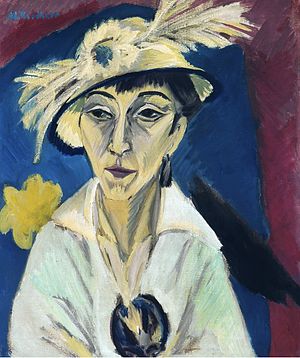Portrait of Erna Schilling

|
| Portrait Erna Schilling (sick woman / lady with hat) |
|---|
| Ernst Ludwig Kirchner , 1913 |
| Oil on canvas |
| 71.5 × 60.5 cm |
| National Gallery, Berlin |
Portrait Erna Schilling (sick woman / lady with hat) is the title of a painting by Ernst Ludwig Kirchner from 1913. It depicts the Berlin night club dancer Erna Schilling who, after Kirchner moved from Dresden to Berlin in 1911, became his first Berlin girlfriend and painter model was. It has been part of the collection of the Berlin National Gallery since 1989 .
History, image content and provenance
After moving from Dresden to Berlin in October 1911, Kirchner met the dancer Erna Schilling and her sister Gerda in a Berlin nightclub. He got Erna out of the milieu , he became her friend and she his painter's model. It was a relationship on an equal footing that lasted until Kirchner's suicide in 1938 in Davos, Switzerland. The painter saw in her a free comrade . In 1913 Erna became ill and had a melancholy, irritable mood that Kirchner portrayed artistically in his picture.
For him, the constitution of an indisposed but elegantly dressed city dweller was an inspiring motif, as it gave him the opportunity to try out a new brushstroke in his painting, a line that pointed, angular and nervous in its style, the situation of the stressed city dwellers should sketch. Elegant clothes, a skeptical facial expression and the associated subtle colors of the person stand in contrast to the brightly colored background. The picture is the beginning of a new phase for Kirchner, which for the first time shows the mature style of his later big city pictures. The art historian Peter-Klaus Schuster interpreted this portrait of Erna Schilling, a self-confident and skeptically distant woman, as a coloristic psychogram of an expressionistic image of man on the eve of the First World War .

Erna and her sister Gerda Schilling can also be seen as a model in his main Berlin factory Potsdamer Platz from 1914.
The portrait has the format 71.5 × 60.5 cm, it is executed in the painting technique oil on canvas and has Kirchner's signature on the upper left: EL Kirchner . The portrait came first in 1916 to the industrialist and art collector Carl Hagemann , a friend of the artist, who was regularly allowed to choose a picture in his studio for a monthly financial support from Kirchner. Hidden in the Frankfurt Städel with the entire Hagemann collection, the work survived the Nazi era . In 1949 it came from his estate to the collector Karlheinz Gabler in Frankfurt am Main. After his death it was on permanent loan to the Staatliche Kunstsammlungen Kassel since 1986 . In 1989 the Berlin Association of Friends of the National Gallery bought it from Gabler's estate administrator, Wolfgang Gabler. The picture has been shown at numerous international exhibitions since the 1950s. For example in 1952 at the Biennale di Venezia , in 1955 at the first Documenta in Kassel, in 1970 in the Munich House of Art , in the exhibition European Expressionism . It was represented in the exhibitions of the Brücke artists in Essen, London and Berlin and in the Kirchner exhibitions in Basel, Seattle and Berlin.
literature
- Hyang-Sook Kim: The "physical ideal of beauty" of women. In: Hyang-Sook Kim: The depictions of women in the work of Ernst Ludwig Kirchner. Hidden self-confessions of the painter. Tectum-Verlag, Marburg 2002, ISBN 3-8288-8407-5 , pp. 73-76, (at the same time: Marburg, Universität, Dissertation, 2001).
- Philip Sefton: The cover. Erna Schilling (sick woman, lady with hat). In: JAMA. The journal of the American Medical Association. dated Nov. 12, 2008. American Medical Association, Chicago, Volume 300, Number 18. ISSN 0098-7484 , p. 2099. ( online )
Web links
- Ernst Ludwig Kirchner - Portrait Erna Schilling (Sick Woman / Lady with Hat), 1913 Website of the Friends of the National Gallery
- Portrait of Erna Schilling / Ill Woman / Lady with Hat on Bildindex.de, with information on Kirchner's picture
Individual evidence
- ^ Peter-Klaus Schuster : Ernst Ludwig Kirchner's Lady with a Hat. On a new acquisition by the Nationalgalerie. In: Yearbook Preussischer Kulturbesitz. Vol. 26, 1989, ISSN 0342-0124 , pp. 283-310.
- ^ Roland März on the website for Kirchner's picture
- ↑ Internet page picture index